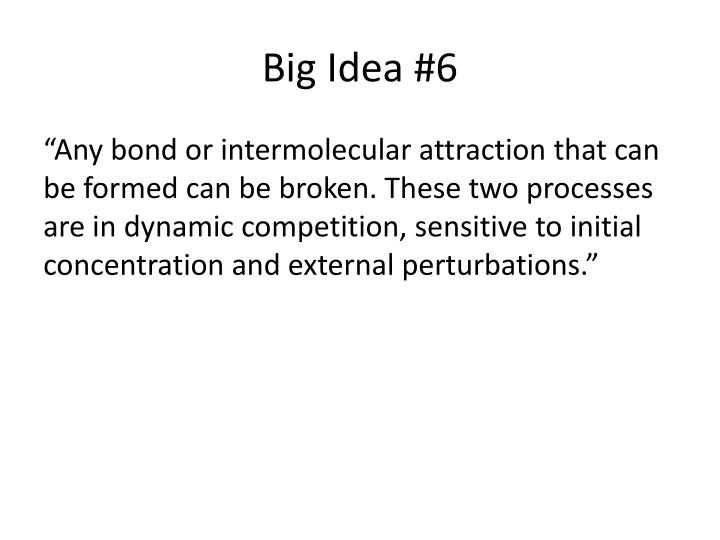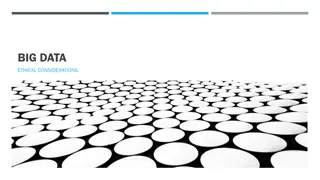
Chemical Equilibrium: Dynamic Processes and Factors
Explore the dynamic competition between bond formation and breaking in chemical equilibrium, influenced by initial concentrations and external disturbances. Learn about equilibrium expressions, Le Chatelier's Principle, reaction quotients, and more.
Download Presentation

Please find below an Image/Link to download the presentation.
The content on the website is provided AS IS for your information and personal use only. It may not be sold, licensed, or shared on other websites without obtaining consent from the author. If you encounter any issues during the download, it is possible that the publisher has removed the file from their server.
You are allowed to download the files provided on this website for personal or commercial use, subject to the condition that they are used lawfully. All files are the property of their respective owners.
The content on the website is provided AS IS for your information and personal use only. It may not be sold, licensed, or shared on other websites without obtaining consent from the author.
E N D
Presentation Transcript
Big Idea #6 Any bond or intermolecular attraction that can be formed can be broken. These two processes are in dynamic competition, sensitive to initial concentration and external perturbations.
Concepts: Equilibrium expression, magnitude of K Le Chatelier s Principle Reaction Quotient Multistep process ( relationship of equilibrium constant) Ksp Common Ion Effect Acid/Base Equilbria Buffers Titration
Equilibrium Review Key topics: Equilibrium expression Equilibrium Constant (Kc) Gas Equilibrium (Kp) Relationship Kc- Kp ICE charts (molar relationships) Reaction Quotient (Q) Le Chatelier s Principle Solubility Constant (Ksp)
Equilibrium expression and Kc Coefficients are used as exponents. Describe concentrations of (aq) and (g) only. Kc = [products]/[reactants] Kc > 1 means equilibrium favors forward direction (formation of product) Kc < 1 describes an equilibrium that favors reverse reaction (formation of reactants) Kc =1 system is at equilbrium
Relationship: Kc & Kp Kc = equilibrium concentrations Kp = equilibrium pressure (gas systems only) Kp = Kc(RT) n(difference in coefficient gaseous products and reactants)
ICE charts Stoichiometric relationship of reactants: products Assume reaction occurs in the forward direction. Some strategies: Perfect square Quadratic equation 5% rule (used when K is very small-compared to initial concentration)
Reaction Quotient (Q) Used to determine the direction required for a system to achieve equilibrium. Q<K - reaction must move forward Q> K reaction must move in reverse Q = K reaction at equilibrium
Le Chateliers Principle Factors that disrupt an equilibrium system: Change in concentration (adding/removing reactants or products) Change in volume/pressure (for gas equilibrium) Change in temperature (endo/exo reactions) 1. 2. 3. Catalyst: allows a system to reach equilibrium more quickly but does not alter the equilibrium.
Basic concepts: Acid-Base chemistry & pH 1. 2. 3. 4. 5. 6. 7. 8. 9. 10. Calculations with equilibrium constants 11. Titration of acid/base and characteristic titration curves Recognizing acid/base and conjugate base/acid Calculation of pH, pOH, [H3O+], [OH-] Calculating pH for solutions of strong acids/base Ionization constant: Ka, Kb Polyprotic acid (and associated Kavalues) pKa, pKb Acid-Base properties of salts Predicting direction of acid-base reaction Types of acid-base reactions
Solubility constant (Ksp) Remember, expression does not include (s) salt(s) cation (aq) + anion(aq) Common ion effect: presence of an ion at the start of the reaction . Alters the solubility (think Le Chatelier) pH and solubility: role of pH may impact the solubility of an insoluble salt based on the common ion effect (ex. Mg(OH)2 enhances by the presence of H+ ions/acidic) Formation of a precipitate- again use Q when Q> Ksp a precipitate will form






















